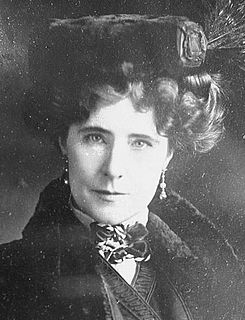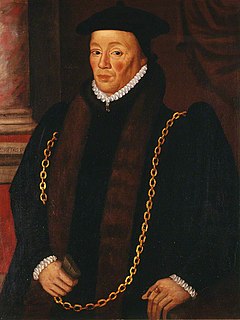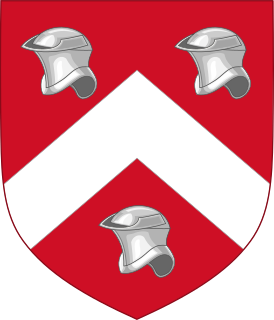Related Research Articles

Sir Walter Mildmay was a statesman who served as Chancellor of the Exchequer to Queen Elizabeth I, and founded Emmanuel College, Cambridge.

Elinor Glyn was a British novelist and scriptwriter who specialised in romantic fiction, which was considered scandalous for its time, although her works are relatively tame by modern standards. She popularized the concept of the it-girl, and had tremendous influence on early 20th-century popular culture and, possibly, on the careers of notable Hollywood stars such as Rudolph Valentino, Gloria Swanson and, especially, Clara Bow.
Cowbridge Grammar School was one of the best-known schools in Wales until its closure in 1974. It was replaced by Cowbridge Comprehensive School.

The Diocese of Chester is a Church of England diocese in the Province of York covering the pre-1974 county of Cheshire and therefore including the Wirral and parts of Stockport, Trafford and Tameside.

Friars School is a school in Bangor, Gwynedd, and one of the oldest schools in Wales.
This article is about the particular significance of the century 1501–1600 to Wales and its people.
Sir William Boleyn of Blickling Hall in Norfolk and Hever Castle in Kent, was a wealthy and powerful landowner who served as Sheriff of Kent in 1489 and as Sheriff of Norfolk and Suffolk in 1500. He was the father of Thomas Boleyn, 1st Earl of Wiltshire, whose daughter was Queen Anne Boleyn, the second wife of King Henry VIII.
John Capon, aliasJohn Salcot was a Benedictine monk who became bishop of Bangor, then bishop of Salisbury under Henry VIII. He is often referred to as John Salcot alias Capon.
William Glyn, also known as William Glynn or William Glynne, was the Bishop of Bangor from 1555 until his death.
Maurice Griffith was a Welshman who became Bishop of Rochester.
Daniel Lewis Lloyd was a schoolteacher and cleric.
William David Davies, often known as W. D. P. Davies, was a Welsh Presbyterian minister and writer on theological topics. After becoming the first Welsh student to obtain a Bachelor of Divinity degree from the University of Oxford, he turned down an offer to become a theology tutor at Oxford, along with a college fellowship, preferring to become a Presbyterian minister. He wrote various theological works and was regarded as an excellent scholar as well as a powerful preacher.

The Cambrian Archaeological Association was founded in 1846 to examine, preserve and illustrate the ancient monuments and remains of the history, language, manners, customs, arts and industries of Wales and the Welsh Marches and to educate the public in such matters. The association's activities include sponsoring lectures, field visits, and study tours; as well as publishing its journal, Archaeologia Cambrensis, and monographs. It also provides grants to support research and publications.

Sir William Garrard (1518–1571), also Garrett, Gerrarde, etc., was a Tudor magnate of London, a merchant citizen in the Worshipful Company of Haberdashers, who became alderman, Sheriff (1552–1553) and Lord Mayor of London (1555–1556) and was returned as an MP for the City of London. He was a senior founding officer of the Company of Merchant Adventurers to New Lands in 1554/55, having been involved in its enterprises since the beginnings in King Edward VI's time, and for the last decade of his life was one of its permanent governors. He worked hard and invested largely to expand English overseas trade not only to Russia and the Levant but also to the Barbary Coast and to West Africa and Guinea.

King's Langley Priory was a Dominican priory in Kings Langley, Hertfordshire, England. It was located adjacent to the Kings Langley Royal Palace, residence of the Plantagenet English kings.
Thomas Davies (1511?–1573) was a Welsh clergyman, Bishop of St Asaph from 1561 to 1573.
John Gwynneth, was a clergyman of Welsh nationality originating from Gwynedd, and was a composer of religious and liturgical vocal music for which he was awarded a doctorate in the University of Oxford. He held benefices in England in Northamptonshire, Bedfordshire and London, and in North Wales at Clynnog Fawr. Although he was a polemicist for the Catholic faith, he maintained his ministry through the reigns of Henry VIII, Edward VI and Queen Mary, and was brother-in-law and executor of Stephen Vaughan. He is principally remembered, from the age of Thomas Tallis, as one of the other exponents of early Tudor period polyphony.

The Tudors of Penmynydd were a noble and aristocratic family, connected with the village of Penmynydd in Anglesey, North Wales, who were very influential in Welsh politics. From this family arose Owen Tudor and thereby the Tudor dynasty, that ruled England from 1485 to 1603. The Tudor dynasty came to an end in the 17th century.

St Edwen's Church, Llanedwen is a 19th-century parish church near the Menai Strait, in Anglesey, north Wales. The first church was founded here by St. Edwen in 640, but the present structure dates from 1856 and was designed by Henry Kennedy, the architect of the Diocese of Bangor. It contains some memorials from the 17th and 18th centuries and a reading desk that reuses panel work from the 14th and 17th centuries. The 18th-century historian Henry Rowlands was vicar here, and is buried in the churchyard. The church is on land that forms part of the Plas Newydd estate, home of the family of the Marquess of Anglesey since 1812 and owned by the National Trust. Some of the Marquesses of Anglesey, and some of their employees, are also buried in the churchyard.